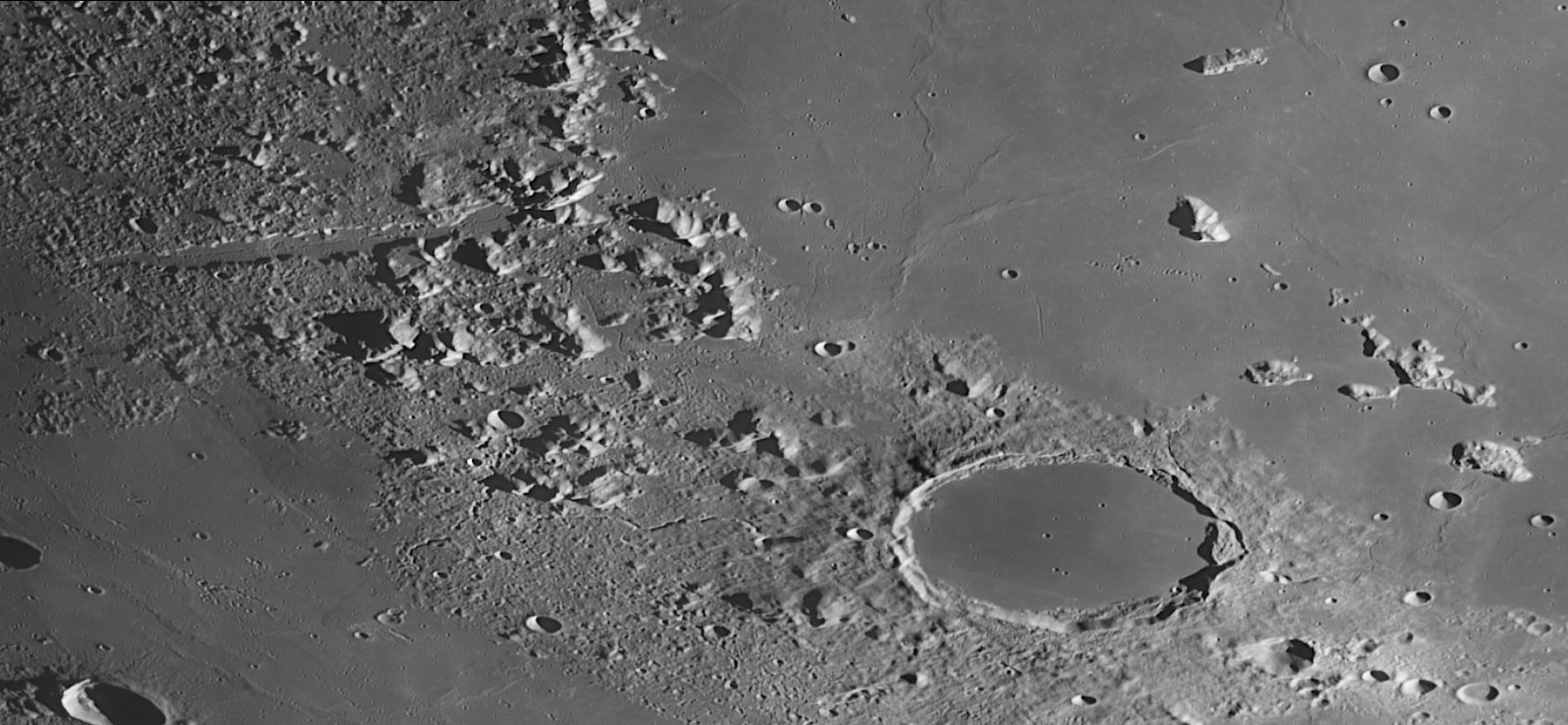November 17, 2017
Panoramic Sweep of Delicate Details
Originally published May 12, 2008

image by Christian Viladrich; south up, east to the left, because its traditional
Truly outstanding images are rare and this one deserves being added to the list. I have discovered no unknown features here, but fantastic confirmation of landforms only imaged once previously. Lets start with the rille on the right side of Plato that winds through the crater's ejecta. Two years ago an image by Wes Higgins first revealed that this rille continues across Mare Imbrium toward the Teneriffe Mountains. Christian's image shows the rille - especially if you download the image and apply a Photoshop unsharp mask filter. Another rille (Plato II), known from spacecraft imaging but perhaps first imaged from Earth by Wes, is east of Plato and wonders through ejecta before crossing into Mare Imbrium. Again, Christian captures this faint rille system. Nearby are the simultaneous impact craters Plato K and KA with the ridge or septum - between them. Moving north just into Mare Frigoris is the concentric crater inner rille traced out in its entirety. There are other fascinating features revealed here, and oh yes, Plato is also shown in this remarkable image.
Chuck Wood
Technical Details
3 September 2007. Celestron 14 at F/20 + Skynyx 2.0M video camera + W15 filter, exposure time: 6.4 ms, gain: 4.2 to 5.4, 12 bits acquisition for Plato, 8 bits acquisition of Alpine valley; 500 images for each frame
Related Links
Rükl plates 3, 4, 11 & 12
Christian's website
Yesterday's LPOD: Volcano M3?
Tomorrow's LPOD: Shafted!
COMMENTS
1) WOW!! I love all the rilles in this photo. I have always wondered about that rille coming off Plato going toward the Teneriffe Mountains. It always appeared to me like it was some how connected with the lava field in Plato, but it appears not in this photo. Is is it possible though for lava to have escaped through fissures in the wall? Aethrae, Andrew Martin SFO
2) South up may have been traditional for lunar charting for many years, but (at least to me) it makes a fine image like this a bit harder to appreciate. Christian's photo has a nice three-dimensionally tipped feel of looking over the curve of the Moon, but for my eyes to understand what they're seeing -- including such things as the north inner wall of Plato being much more visible than the south one -- I have to convince my brain that I'm looking up at a slanted surface, like viewing the underbelly of an airplane. This may not be a problem when seen through the eyepiece, but taken out of context, as it is here, it seems uncomfortable. By comparison, if a lunar image is rotated with the limbward side at the top, then it has the feel of looking down on a ball (or globe). To me, that's much more natural and easier on the eyes. I also find the absence of any clear information as to the time or observing location a bit unsettling. But, it's a fine image nonetheless. -  JimMosher
JimMosher
3) Andrew - there is no evidence that lava escaped from within Plato, but the lava there rose of fissurs beneath the crater and similar ones probably fed the sinuous rilles that have their sources near Plato.
Jim - One benefit of looking at images from unexpected directions is that you (or at least I) notice different things on the surface. Sometimes I rotate an image through 360° and do all sorts of extreme stretches to find everything hiding in it!
--Chuck
Image of rille to east http://www.lpod.org/?m=20061130
COMMENTS?
Register, Log in, and join in the comments.



